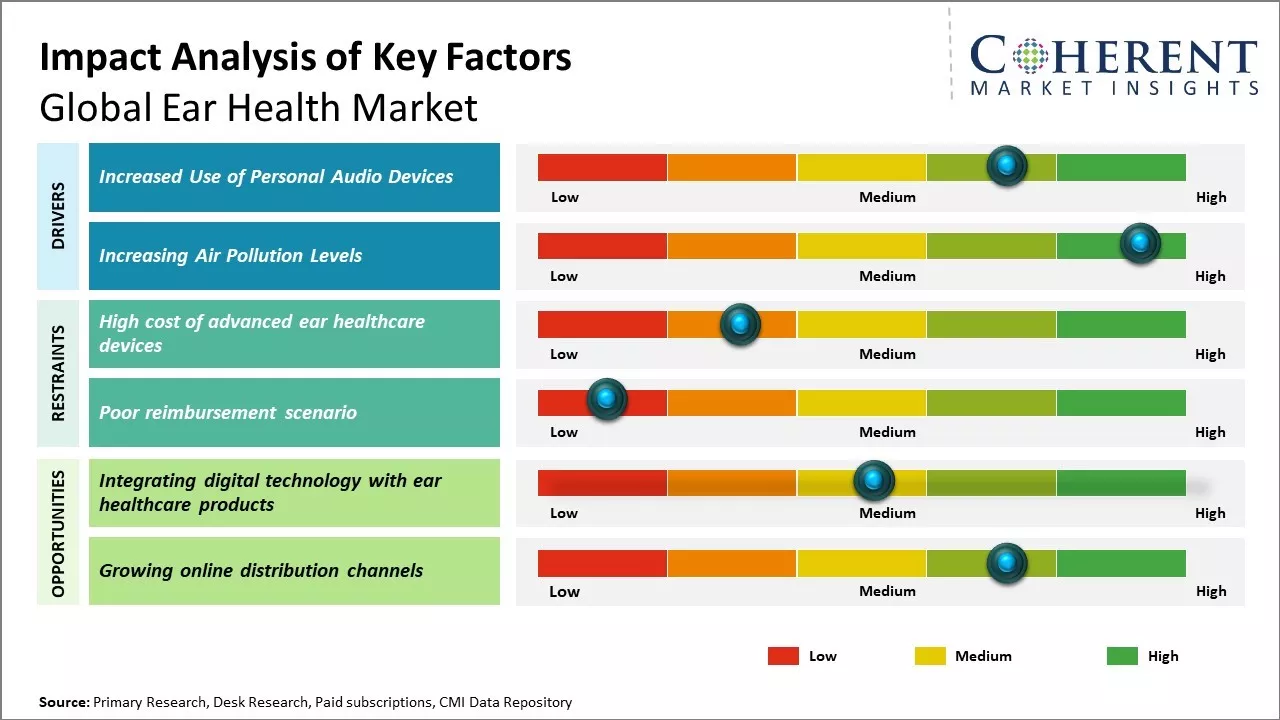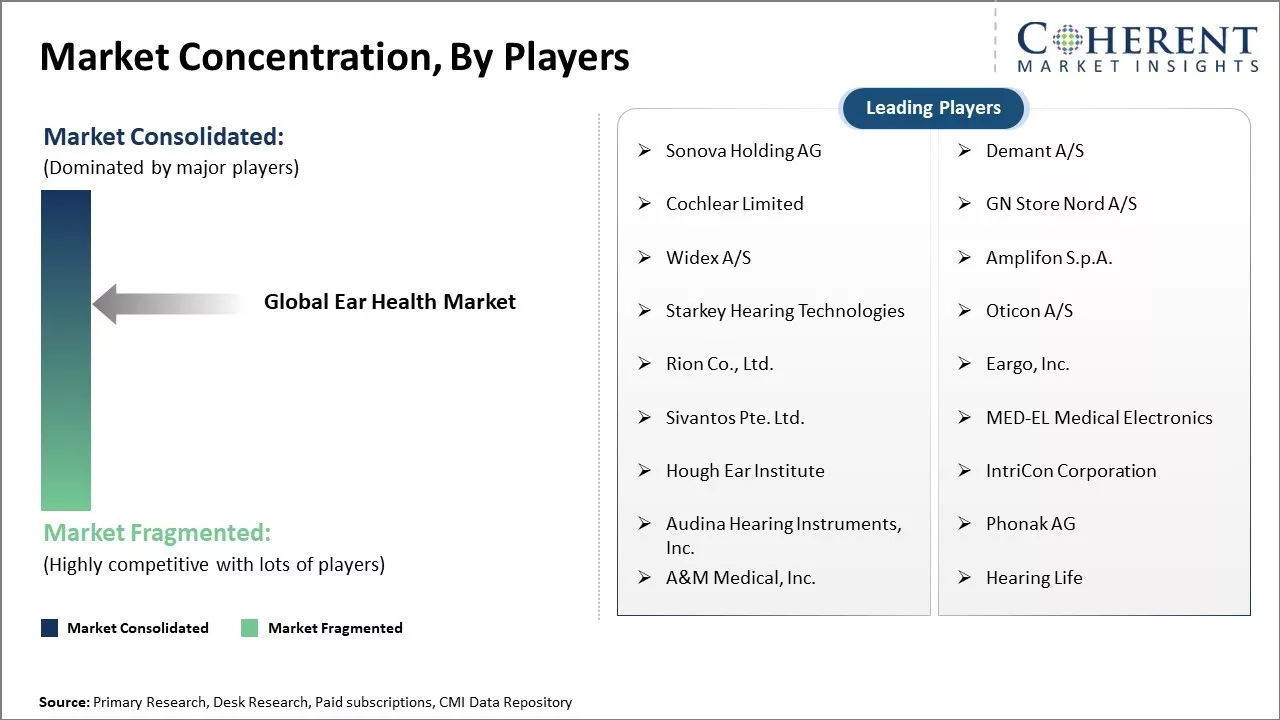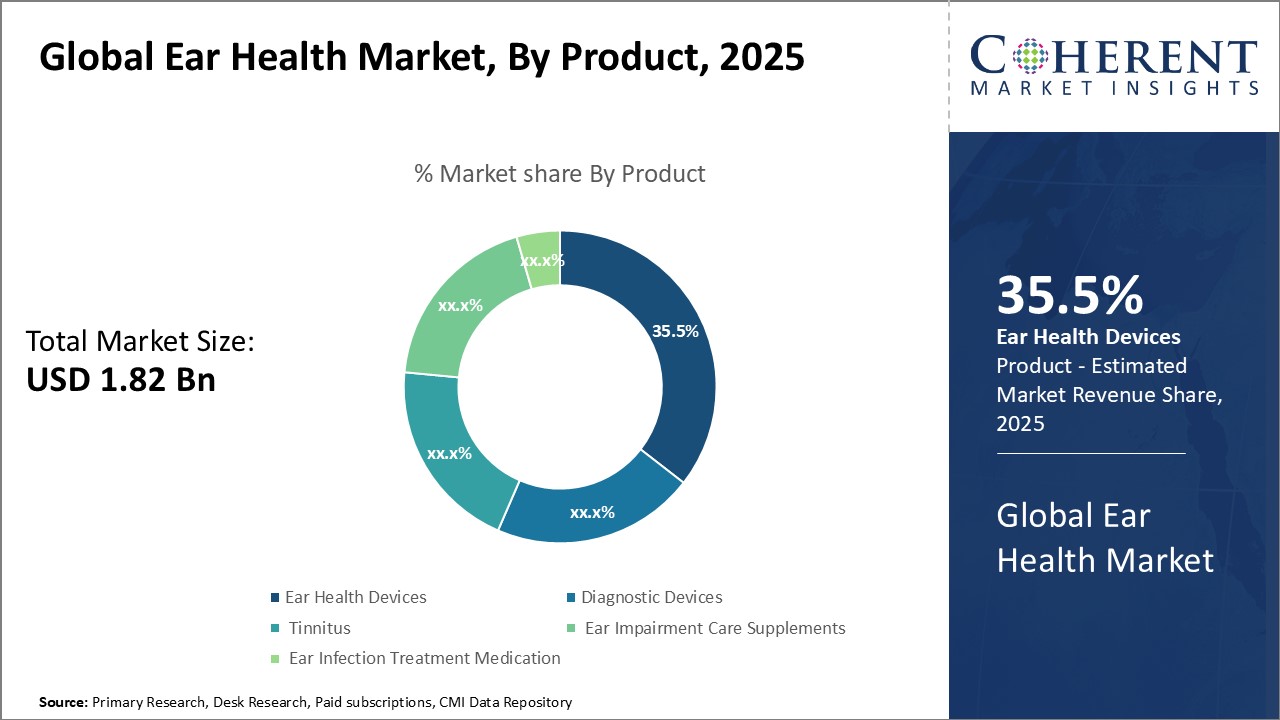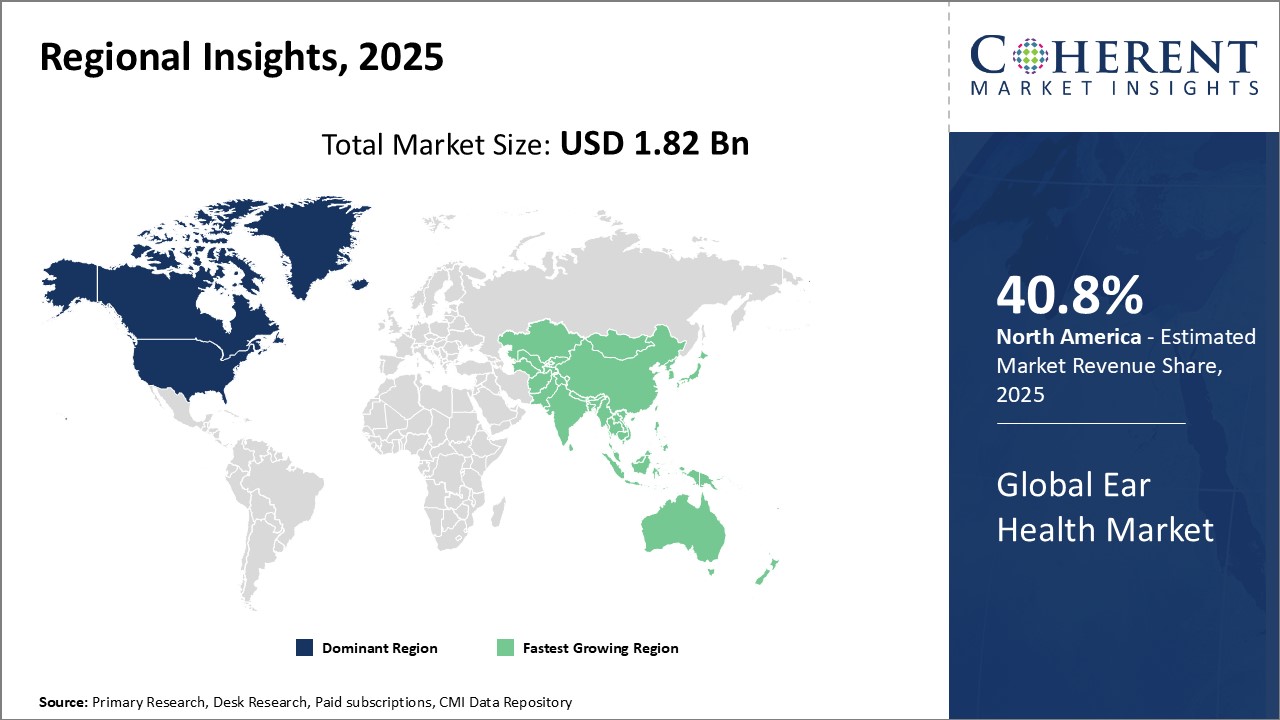Global Ear Health Market Size and Trends
Global ear health market is estimated to be valued at USD 1.82 Bn in 2025 and is expected to reach USD 2.90 Bn by 2032, exhibiting a compound annual growth rate (CAGR) of 6.9% from 2025 to 2032.

Discover market dynamics shaping the industry: Download Free Sample
Rising prevalence of hearing disorders worldwide due to increased noise pollution and growing geriatric population can boost demand for advanced ear health solutions. Additionally, innovations in otology and increasing applications of stem cell therapeutics in treatments can offer potential opportunities for market players. However, high costs associated with ear surgeries and lack of awareness regarding ear diseases in developing nations can hamper the market growth over the forecast period.
Market Driver: Increased Use of Personal Audio Devices
With each passing year, more people are using personal audio devices on a daily basis. Whether it is listening to music during workout or commute, binge watching shows on mobile devices, playing video games on consoles, or taking online classes - audio devices have become an intrinsic part of one’s lives. However, prolonged and high-volume usage of headphones and earphones can negatively impact ear health. According to studies, regular and prolonged exposure to loud sounds from personal audio devices can lead to noise-induced hearing loss (NIHL) in younger individuals. NIHL occurs when the hair cells in the inner ear are damaged due to exposure to intense sound over long periods of time. This damage is permanent and progressive, and can affect one's ability to hear and understand sounds even when using hearing aids. As the usage of audio devices increases around the world due to changing lifestyles, work patterns and entertainment preferences, more people are at risk of suffering from NIHL and other ear-related problems if not used responsibly. This rising threat to ear health has compelled individuals to become more aware and proactive regarding ear care. Companies are focusing on developing earphones with smarter hearing protection technologies that can monitor sound exposure levels and cut off volume automatically, if it crosses safe limits. Individuals are also incorporating exercises and supplements in their routine that can enhance immune response in inner ear and reduce risk of noise-induced damage. Continued penetration of audio devices globally and growing knowledge about ear health issues can drive the growth of global ear health market in the near future.
Market Concentration and Competitive Landscape

Get actionable strategies to beat competition: Download Free Sample
Increasing Air Pollution Levels
Air pollution has increased dramatically across both urban and rural areas around the world. Growing industrial emissions, rising vehicle usage, construction activities and pollution from burning of fossil fuels have overburdened the atmospheric environment with unhealthy pollutants like particulate matter, volatile organic compounds, nitrogen oxides, and Sulphur oxides. These airborne pollutants can directly enter inside the body through breath and bloodstream, and also lodge inside middle ear, thus, leading to adverse effects on ear health. Several studies show a strong correlation between higher air pollution exposure and increased risk of middle ear infection like otitis media in both children and adults. Polluted air weakens immune defenses of mucous membranes in middle ear, making it vulnerable to microbial invasion and inflammation. Prolonged exposure to traffic or industrial air pollution has been linked to premature hearing loss and impairment. The tiny pollutant particles generate oxidative stress inside inner ear tissues causing damage to hair cells over time. With rapid urbanization and growing use of fossil fuels in developing economies, air pollution crisis is further worsening unabatedly which will continue to threaten ear health globally. Rising awareness about ill-effects of toxic air prompt more people to take corrective measures like wearing pollution masks, following better indoor ventilation, using ear drops and consulting ENT experts. This can drive the growth of global ear health market.
Key Takeaways from Analyst:
Global ear health market growth is driven by increasing cases of ear infections and hearing impairment worldwide. Rising air pollution levels and growing geriatric population susceptible to ear disorders can boost demand for ear drops and other ear care products. However, stringent regulations pertaining to new product approvals can pose challenges for market players. Asia Pacific region dominates the market, and is expected to be the fastest growing regional market. Factors such as large population base, rising awareness about ear disorders, and improving healthcare infrastructure in emerging countries can drive the Asia Pacific ear health market growth.
Among product, ear drops will continue capturing the largest revenue share due to rising demand for over-the-counter medications to treat ear infections and relieve ear pain effectively. However, hearing aids segment is poised to register the highest CAGR through 2027 due to increasing acceptance of digital devices offering greater convenience to users.
Players operating in the ear health market are focusing on expanding their geographic footprint in emerging nations. These must also invest in R&D activities to develop novel drugs and devices with enhanced efficacy and fewer side effects.
Market Challenges: High cost of advanced ear healthcare devices
The high costs of advanced ear healthcare devices can hamper widespread adoption of these technologies and can hamper the global ear health market growth. Advanced devices such as wireless earbuds, hearing aids, and in-ear monitors that provide precise diagnosis and treatment for conditions like hearing loss, ear infections, and other ear-related issues are expensive, which is prohibitive for many consumers. These sophisticated ear devices have tremendous benefits in terms of better comfort, discretion, and efficacy in treatment, however, their costs ranging anywhere between US$ 500 to US$ 8,000 makes them inaccessible for low-income groups and those with limited or no health insurance. This is denying the benefits of early diagnosis and effective management of ear health issues to large sections of the population globally. The high costs also act as a deterrent for regular replacements and upgrades that such devices require to maintain optimal performance levels over the long term. This is concerning as untreated or poorly managed ear health issues can seriously affect quality of life by causing impediments in hearing, speech, language, and cognitive development especially in children. As per the data from the World Health Organization (WHO), around 5.0% of the global population suffers from disabling hearing loss as of 2020. However, the treatment rate for hearing loss is only estimated to be around 14.0% in low- and middle-income countries due to resource limitations and the high costs associated with ear care. If left untreated, hearing loss and other ear conditions can have severe socio-economic impacts in the form of poor educational and employment outcomes.
Market Opportunities: Integrating digital technology with ear healthcare products
Integrating digital technology with ear healthcare products can provide great opportunities for the global ear health market growth. With the rise of telehealth and remote patient monitoring during the COVID-19 pandemic, digital health solutions have become increasingly important. Ear health products that combine hardware devices, mobile apps, and cloud-based services allow for more convenient access to care as well as remote monitoring of conditions like hearing loss. This can help overcome barriers like limited access to specialists in rural areas. By digitizing ear examinations and tests, clinicians and patients have more flexible options that does not require in-person visits. For example, ear buds or headphones that can conduct scanning, tests and send the results electronically can help diagnose ear infections or monitor hearing levels from home. This provides both providers and patients valuable data over time to track progress and catch issues early. Digital tutorials, fitness trackers or apps that provide guidance on ear care techniques, risks to avoid and reminders for re-testing can also promote better long-term self-management of conditions. As the global population ages and develops more ear-related chronic illnesses, preventive care and remote monitoring outside of traditional clinic settings will be critical to maintain health outcomes and reduce costs. According to the World Health Organization, over 5% of the world's population - or 466 million people - have disabling hearing loss. By 2050, over 900 million people are projected to have benign ear conditions that impact hearing.

Discover high revenue pocket segments and roadmap to it: Download Free Sample
By Product: Rising Prevalence of Hearing Disorders Drives Growth of Ear Health Devices
By product, ear health devices segment is estimated to contribute the highest market share of 35.5% in 2025, owing to rising prevalence of hearing disorders. Hearing loss is one of the most common health conditions worldwide, affecting over 430 million people. The prevalence of hearing loss is steadily increasing each year due to aging populations and growing noise pollution levels in both developed and developing countries. Age-related hearing loss alone is projected to affect over 900 million people by 2050. The development of innovative ear health devices also play a key role in expanding access to treatment. Devices such as hearing aids, ear thermometers, and ear vacuum systems have made it easier for people to monitor and manage common ear conditions at home. Advanced digital hearing aids with rechargeable batteries and miniature designs have improved functionality while reducing stigma. Over-the-counter devices allow for self-testing and treatment of mild hearing loss without medical visits. Their lower cost has boosted adoption rates. Physicians are also recommending routine use of preventive ear health devices. For instance, noise-cancelling headphones are being used to protect young people from damage to their hearing due to prolonged exposure to loud music. Swimmer's plugs prevent ear infections in those prone to water exposure. Early diagnosis and treatment through regular use of screening devices can curb the growth of infectious and inflammatory ear diseases over time. Growing geriatric demographic susceptible to age-related impairments boosts demand for assistive listening solutions. Favorable reimbursement coverage for hearing aids in some countries further encourages the medicalization of hearing care. Thus, ear health devices segment will dominate the market, owing to the preventive and therapeutic benefits these products provide for common ear disorders.
By End Users: Audiology Centers Lead Due to Access to Specialized Care
Among end users, audiology centers segment is estimated to contribute the highest market share of 48.5% in 2025, owing to their ability to provide specialized diagnostic and treatment services. Audiologists are highly trained professionals specializing in auditory and vestibular disorders. These offer comprehensive evaluation, rehabilitation and management for all types of hearing and balance issues across both pediatric and adult patients. Many people prefer visiting audiology centers over other healthcare settings due to factors such as detailed hearing assessments, on-site dispensing of hearing aids and assistive devices, and coverage of follow-up care. Audiologists leverage advanced technologies like audiometers, tympanometers and otoacoustic emission testing for in-depth hearing evaluations that primary physicians lack. Their expertise makes them the preferred first point of contact for ear-related concerns. Audiology centers promote prevention through community outreach activities. These provide hearing screenings and education programs to raise awareness on issues like noise-induced hearing loss. This allows for early detection and intervention before conditions become severe. Their focus on long-term management helps improve patient compliance to treatment plans through counseling and support. With growing public knowledge about hearing healthcare, more patients are opting for specialists rather than opting for general practitioners.
Regional Insights

Need a Different Region or Segment? Download Free Sample
North America dominates the global ear health market with an estimated market share of 40.8% in 2025, owing to strong industry presence and high consumer spending in the region. The U.S. market alone accounts for over 40.5% of the global sales due to easy access to advanced ear care products and rising awareness regarding ear related issues. Key players in the market have their global headquarters located in the U.S., which provides them an edge in terms of R&D investment and new product launches first in the region. Favorable reimbursement policies have ensured higher adoption rates of prescription-based products compared to other regions.
Asia Pacific region has been experiencing phenomenal growth and has emerged as the fastest growing market for ear health worldwide. Rapidly developing healthcare infrastructure and rising living standards across countries like China, India and Southeast Asia have bolstered overall consumer spending on personal health. These economies are also expected to outpace global GDP growth in the coming decade, expanding the middle-income consumer base exponentially. This socio-economic transition coupled with growing awareness is contributing to uptake of ear health products. The prevalence of ear related issues like ear infection and hearing loss is also high among the pediatric population in the region, and this drives the market growth.
Market Report Scope
Global Ear Health Market Report Coverage
| Report Coverage | Details | ||
|---|---|---|---|
| Base Year: | 2024 | Market Size in 2025: | USD 1.82 Bn |
| Historical Data for: | 2020 To 2024 | Forecast Period: | 2025 To 2032 |
| Forecast Period 2025 to 2032 CAGR: | 6.9% | 2032 Value Projection: | USD 2.90 Bn |
| Geographies covered: |
|
||
| Segments covered: |
|
||
| Companies covered: |
Sonova Holding AG, Demant A/S, Cochlear Limited, GN Store Nord A/S, Widex A/S, Amplifon S.p.A., Starkey Hearing Technologies, Oticon A/S, Rion Co., Ltd., Eargo, Inc., Sivantos Pte. Ltd., MED-EL Medical Electronics, Hough Ear Institute, IntriCon Corporation, Audina Hearing Instruments, Inc., Phonak AG, A&M Medical, Inc., and Hearing Life |
||
| Growth Drivers: |
|
||
| Restraints & Challenges: |
|
||
Uncover macros and micros vetted on 75+ parameters: Get instant access to report
Global Ear Health Industry News
- In October 2022, Sony Electronics launched its first over-the-counter (OTC) hearing aids for the U.S. market. Developed in collaboration with WS Audiology, these innovative devices aim to enhance consumer experiences with premium technology, ease of use, and exceptional comfort, bridging the gap between wearers and their surroundings.
- In November 2021, InnerScope Hearing Technologies (USA) acquired Atlazo Inc. (U.S.) to develop advanced hearing aids and devices leveraging Atlazo's innovative AI hardware platform In May 2021, Sonova Holding AG acquired Sennheiser to broaden its product portfolio and enter new growth markets.
*Definition: Global Ear Health Market involves the manufacturing and sales of various ear care products aimed at improving and maintaining ear health. This includes over-the-counter products like ear drops and ear syringes used to treat ear pain, ear infections, earwax removal and other common ear problems. It also involves prescription medications and devices prescribed by doctors to treat more severe issues like swimmers ear, perforated eardrums and hearing loss. The market covers products sold around the world targeting both adults and children with various ear health issues.
Market Segmentation
- Product Insights (Revenue, USD Bn, 2020 - 2032)
- Ear Health Devices
- Diagnostic Devices
- Tinnitus and Ear Impairment Care Supplements
- Ear Infection Treatment Medication
- End Users Insights (Revenue, USD Bn, 2020 - 2032)
- Audiology Centers
- ENT Clinics
- Home Healthcare
- Hospitals
- Others
- Regional Insights (Revenue, USD Bn, 2020 - 2032)
- North America
- U.S.
- Canada
- Latin America
- Brazil
- Argentina
- Mexico
- Rest of Latin America
- Europe
- Germany
- U.K.
- Spain
- France
- Italy
- Russia
- Rest of Europe
- Asia Pacific
- China
- India
- Japan
- Australia
- South Korea
- ASEAN
- Rest of Asia Pacific
- Middle East
- GCC Countries
- Israel
- Rest of Middle East
- Africa
- South Africa
- North Africa
- Central Africa
- North America
- Key Players Insights
- Sonova Holding AG
- Demant A/S
- Cochlear Limited
- GN Store Nord A/S
- Widex A/S
- Amplifon S.p.A.
- Starkey Hearing Technologies
- Oticon A/S
- Rion Co., Ltd.
- Eargo, Inc.
- Sivantos Pte. Ltd.
- MED-EL Medical Electronics
- Hough Ear Institute
- IntriCon Corporation
- Audina Hearing Instruments, Inc.
- Phonak AG
- A&M Medical, Inc.
- Hearing Life
Share
Share
About Author
Vipul Patil is a dynamic management consultant with 6 years of dedicated experience in the pharmaceutical industry. Known for his analytical acumen and strategic insight, Vipul has successfully partnered with pharmaceutical companies to enhance operational efficiency, cross broader expansion, and navigate the complexities of distribution in markets with high revenue potential.
Missing comfort of reading report in your local language? Find your preferred language :
Transform your Strategy with Exclusive Trending Reports :
Frequently Asked Questions
EXISTING CLIENTELE
Joining thousands of companies around the world committed to making the Excellent Business Solutions.
View All Our Clients
